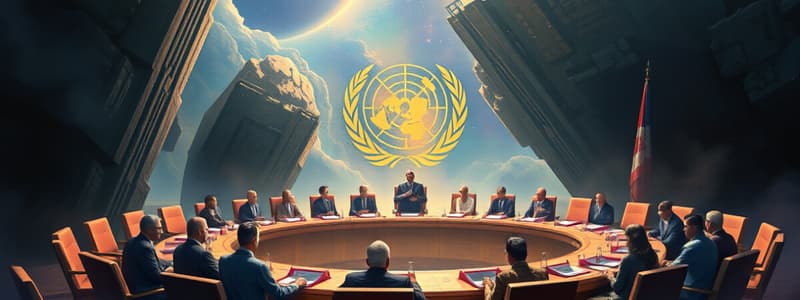Podcast
Questions and Answers
What is Chapter VII focused on?
What is Chapter VII focused on?
- Economic sanctions
- Human rights violations
- Threats to the peace (correct)
- International treaties
Chapter VII was explicitly referenced in early Security Council resolutions.
Chapter VII was explicitly referenced in early Security Council resolutions.
False (B)
What was the significance of Resolution 253?
What was the significance of Resolution 253?
It was the first resolution to explicitly state that it was 'acting under Chapter VII'.
What is determined by Article 39 of Chapter VII?
What is determined by Article 39 of Chapter VII?
What are provisional measures mentioned in Article 40 intended to do?
What are provisional measures mentioned in Article 40 intended to do?
What does Article 41 of Chapter VII address?
What does Article 41 of Chapter VII address?
What kind of measures does Article 42 provide for?
What kind of measures does Article 42 provide for?
What is the purpose of Articles 43-47?
What is the purpose of Articles 43-47?
Chapter VII is widely interpreted and does not always explicitly reference its powers.
Chapter VII is widely interpreted and does not always explicitly reference its powers.
What do Articles 48-51 cover?
What do Articles 48-51 cover?
Flashcards are hidden until you start studying
Study Notes
Chapter VII Overview
- Addresses action concerning threats to peace, breaches of the peace, and acts of aggression.
- Provides the framework for the Security Council to undertake enforcement actions.
Early Stages of Security Council and Chapter VII
- Initially, Chapter VII was rarely invoked explicitly in resolutions.
- Resolution 54 (1948) concerning Palestine and Resolution 83 (1950) regarding Korea were based on Chapter VII, but did not state so explicitly.
Resolution 253
- Responded to the Southern Rhodesia conflict.
- Broadened the application of force and strengthened sanctions.
- First resolution to explicitly declare "acting under Chapter VII."
Article 39
- Determines threats to peace, breaches of peace, or acts of aggression.
- Country-specific examples include the Iraqi invasion of Kuwait (1990) and the Rwandan Civil War (1993).
- Covers political threats like terrorist attacks (e.g., Afghanistan, Taliban - 1999) and proliferation of weapons of mass destruction (WMDs).
Article 40
- Focuses on provisional measures to prevent escalation.
- Can involve withdrawal of armed forces, cessation of hostilities, and observance of ceasefires.
Article 41
- Involves measures that do not require armed force.
- Includes sanctions, international tribunals (e.g., for Rwanda and Yugoslavia), and compensation funds.
Article 42
- Entails measures to maintain or restore international peace and security.
- Includes peacekeeping operations (e.g., United Nations Mission in Sierra Leone - 1999), multinational forces, and regional interventions.
Articles 43-47
- Outline command and deployment of military forces.
- Article 43 mandates Member States to provide assistance for maintaining international peace.
- Article 44 requires consultations with troop-contributing countries.
- Article 45 discusses provision of air-force contingents.
- Article 46 addresses assistance by the Military Staff Committee.
- Article 47 describes the composition of the Military Staff Committee.
Issues with Chapter VII
- The broad scope of Chapter VII leads to varying interpretations and expands the Security Council's influence.
- Powers exercised under Chapter VII are not always explicitly referenced in resolutions.
- Resolutions may include non-binding directives.
- Decisions can reflect the political interests of Security Council Member States rather than solely international peace and security.
Articles 48-51
- Article 48 emphasizes Member States' obligation to follow the Council's binding decisions.
- Article 49 establishes mutual assistance in implementing Council decisions.
- Article 50 outlines the impact of Council measures on third States.
- Article 51 affirms the right to individual or collective self-defense.
Studying That Suits You
Use AI to generate personalized quizzes and flashcards to suit your learning preferences.




